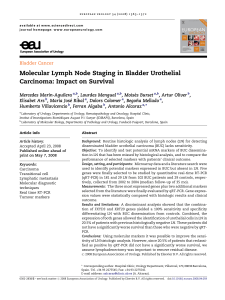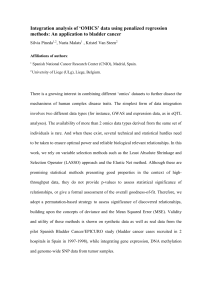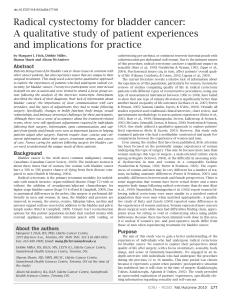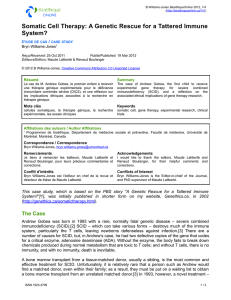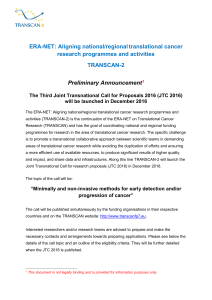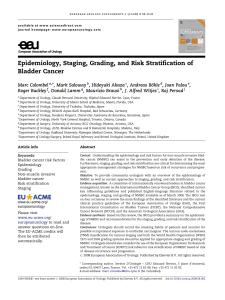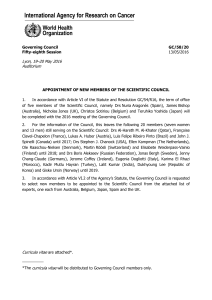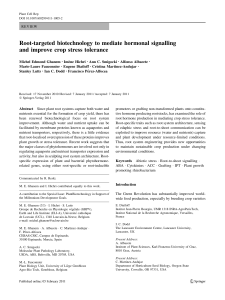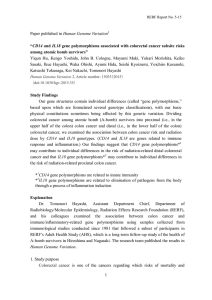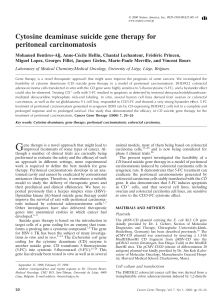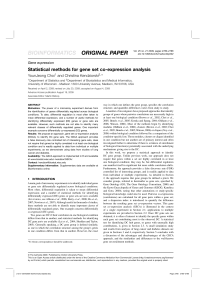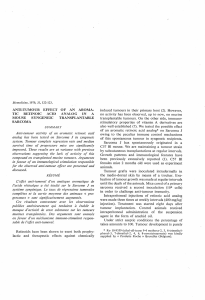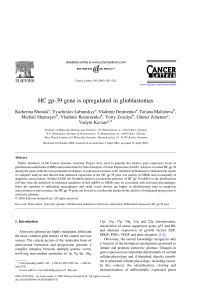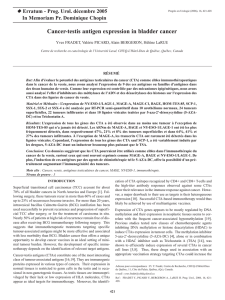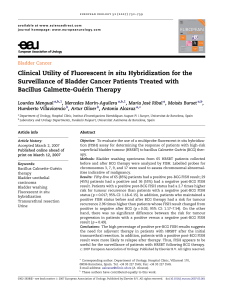Molecular mRNA markers to detect ... peripheral blood from urothelial carcinoma patients
publicité
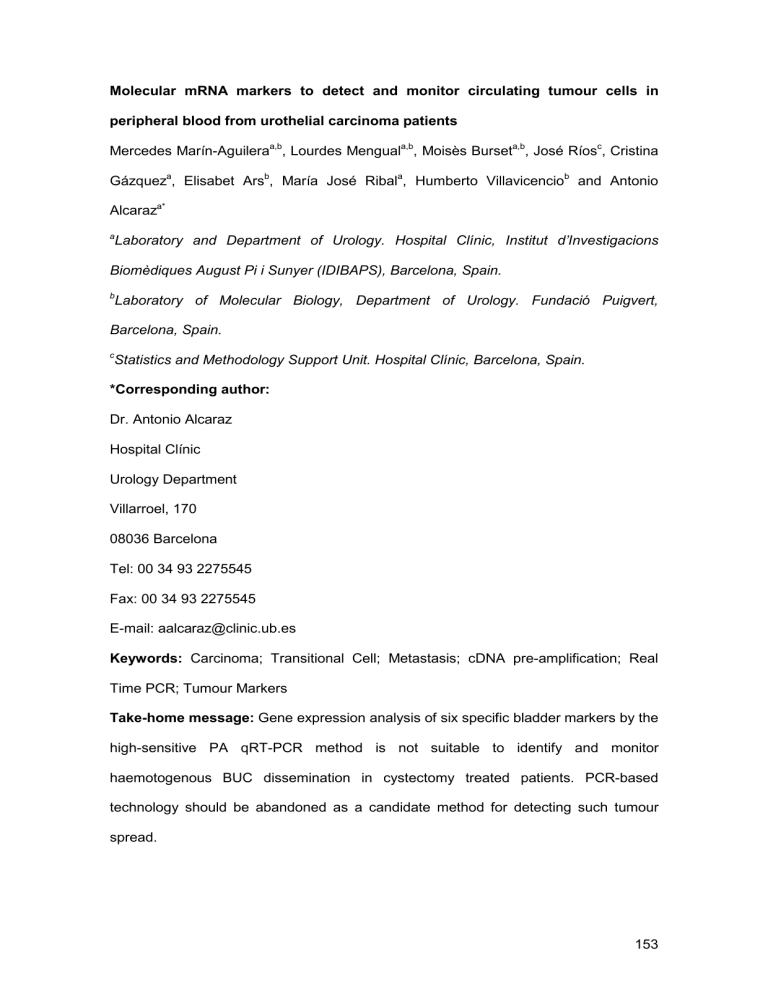
Molecular mRNA markers to detect and monitor circulating tumour cells in peripheral blood from urothelial carcinoma patients Mercedes Marín-Aguileraa,b, Lourdes Menguala,b, Moisès Burseta,b, José Ríosc, Cristina Gázqueza, Elisabet Arsb, María José Ribala, Humberto Villavicenciob and Antonio Alcaraza* a Laboratory and Department of Urology. Hospital Clínic, Institut d’Investigacions Biomèdiques August Pi i Sunyer (IDIBAPS), Barcelona, Spain. b Laboratory of Molecular Biology, Department of Urology. Fundació Puigvert, Barcelona, Spain. c Statistics and Methodology Support Unit. Hospital Clínic, Barcelona, Spain. *Corresponding author: Dr. Antonio Alcaraz Hospital Clínic Urology Department Villarroel, 170 08036 Barcelona Tel: 00 34 93 2275545 Fax: 00 34 93 2275545 E-mail: [email protected] Keywords: Carcinoma; Transitional Cell; Metastasis; cDNA pre-amplification; Real Time PCR; Tumour Markers Take-home message: Gene expression analysis of six specific bladder markers by the high-sensitive PA qRT-PCR method is not suitable to identify and monitor haemotogenous BUC dissemination in cystectomy treated patients. PCR-based technology should be abandoned as a candidate method for detecting such tumour spread. 153 ABSTRACT Background: Detecting haematogenous spread of bladder urothelial carcinoma (BUC) still represents a major challenge in clinical practice. Objective: To test the efficiency of six mRNA bladder markers in detecting and monitoring BUC haematogenous dissemination. Design, Setting, and Participants: Between 2002 and 2004, 317 peripheral blood (PB) samples were collected from 101 patients with BUC that underwent radical cystectomy and from 29 healthy controls. Sequential PB sampling was performed in patients at time of surgery and at 6, 12, 18 and 24 months afterwards. Median patients’ follow-up was 35 months. Measurements: The presence of disseminated urothelial cells in PB was evaluated by measuring gene expression from pre-amplified (PA) cDNA of KRT20, FXYD3, C10orf116, UPK2, AGR2 and KRT19 genes, using quantitative RT-PCR (qRT-PCR). Gene expression data were correlated with patients’ follow-up and outcome. Results and limitations: The PA qRT-PCR method with selected markers in PB was able to detect 2 cells in between 106-107leucocytes, depending on the gene. Differential gene expression was found between patients and controls for FXYD3 (p=0.002), C10orf116 (p=0.001), AGR2 (p=0.003) and KRT19 (p<0.001) genes. In contrast, no differences were found between gene expression from metastasized and recurrencefree patients (p=ns). Molecular monitoring of clinically metastasized patients did not show an increased gene expression for selected markers in blood throughout the follow-up after surgery. Conclusions: Gene expression analysis of PB samples using six specific bladder mRNA markers can distinguish between BUC patients and controls. However, despite its high sensitivity, PA qRT-PCR with these potential markers is not a suitable approach for detecting and monitoring BUC haematogenous dissemination. Thus, PCR-based technology should be abandoned as a candidate method for detecting such tumour spread. 154 1. Introduction Bladder urothelial carcinoma (BUC) is one of the most aggressive epithelial tumours, with a high rate of haematogenous and lymphatic dissemination. Cystectomy is the gold standard of treatment for patients with clinically localized muscle-invasive BUC. However, despite this radical treatment, around 50% of patients die within 5 years of follow-up [1]. Such a high treatment failure rate is usually due to occult metastatic disease which is not detected by conventional staging at the time of treatment [2]. Although lymph-node metastasis often represents an early prognostic indicator of tumour invasiveness and metastatic dissemination, several works have focused on detecting disseminated BUC cells in peripheral blood (PB) to monitor the metastatic progression and response to chemotherapy [3-6]. Detecting such tumour dissemination could be used in planning the optimal treatment and follow-up after radical cystectomy. However, none of these strategies for detecting tumour cells in PB have yet been incorporated into clinical practice. Recently, we have described a list of bladder specific mRNA markers obtained from the comparison of microarray data from bladder and PB tissues. Selected markers from this analysis (KRT20, FXYD3, C10orf116, UPK2, AGR2 and KRT19) were used to detect lymphatic BUC dissemination by quantitative RT-PCR (qRT-PCR), showing a high sensitivity and specificity detecting disseminated tumour cells [7]. QRT-PCR provides the advantages of being quantitative and more sensitive than conventional RT-PCR in detecting rare events [8]. In addition, the sensitivity of qRT-PCR can further be increased by a novel cDNA pre-amplification (PA) method that allows increasing the quantity of specific cDNA targets prior to gene expression analysis [9;10]. In the present work we test the usefulness of six highly specific bladder markers in detecting and monitoring the development of BUC dissemination in PB by a method that combines PA of cDNA and qRT-PCR. The sensitivity of this method was assessed by PB spiking experiments with dissociated cells from a BUC specimen. The clinical 155 applicability of this highly sensitive test was determined correlating gene expression values with patients’ follow-up and outcome. 2. Material and Methods 2.1 Patients and samples A total of 317 PB samples from 101 patients (10 women and 91 men; average 69 yr; range 44-86 yr) who underwent radical cystectomy and pelvic lymphadenectomy between August 2002 and July 2004 were included in this study. Only patients with transitional cell carcinoma were considered. Five and 30 patients underwent neoadjuvant and adjuvant chemotherapy, respectively. Six patients underwent chemotherapy as a treatment for the metastasis. Clinical and pathological stages of patients’ tumours [11;12] are shown in table 1. PB samples (8-10 mL) were collected into EDTA-containing blood collection tubes (Sarstedt Monovette, NümbrechtRommelsdorf, Germany) just before the cystectomy (101 samples) and subsequently at 6 (73 samples), 12 (55 samples), 18 (49 samples) and 24 (39 samples) months after surgery. As controls, PB from 29 healthy volunteers (23 women and 6 men; average age 32; range 22-62 yr) were also collected. To avoid epithelial contamination by the skin during venipuncture, the first 5 mL of blood was discarded. The hospital ethics committee approved this study and the patients and controls provided their informed consent before participating in the study. 2.2 Marker selection To determine a panel of highly specific mRNA markers for BUC dissemination, gene expression from bladder tissue (normal and tumour) and blood were compared by microarrays analysis [7]. Those four genes with the highest expression in urothelial tissue but lowest expression in blood (FXYD3, C10orf116, AGR2, and KRT19) were selected as potential candidates for haematogenous BUC dissemination. KRT20 and UPK2, two conventional markers for epithelial cells that have been widely tested as BUC dissemination markers in the bibliography, were also selected for study [13-16]. 2.3 RNA extraction and Reverse Transcription 156 PB specimens were layered onto 10 mL of Ficoll-Paque (GE Healthcare Life Sciences, Uppsala, Sweden). Mononuclear cells were isolated and total RNA was extracted using the Trizol Reagent (Invitrogen Life Technologies, Carlsbad, CA, USA) according to the manufacturer’s instructions. Quantity of total RNA was assessed by absorbance at 260 nm in an Ultrospec 3100 pro spectrophotometer (GE Healthcare Life Sciences, Uppsala, Sweden). Five µg of total RNA were reverse-transcribed with a random hexamer primer mix in a 20 µl reaction mix using SuperScriptII Reverse Transcriptase (Invitrogen Life Technologies, Carlsbad, CA, USA) according to the manufacturer’s instructions. 2.4 Pre-amplification and qRT-PCR analysis cDNA from control PB specimens (n=29), from PB samples obtained at time of the surgery (n=101) and from samples obtained at 6, 12, 18 and/or 24 months after the surgery from patients who recurred or died because of the cancer (n=47) were preamplified. This pre-amplification (PA) was performed by means of a multiplex PCR with the 6 specific bladder mRNA markers (KRT20, FXYD3, C10orf116, UPK2, AGR2 and KRT19) and the endogenous control GUSB, using the TaqMan PreAmp Master Mix Kit following manufacturer’s instructions (Applied Biosystems), except that the final volume of the reaction was 25 µl. Briefly, the 7 TaqMan Gene Expression Assays (Applied Biosystems) were pooled together at 0.2X of final concentration. Subsequently, 6.25 µl of this assay mix were combined with 1.25 µl of cDNA (equivalent to 125 ng) and 12.5 µl of the TaqMan PreAmp Master Mix (2X) in a final volume of 25 µl. Thermal cycling conditions were as follows: initial hold at 95ºC during 10 min and ten pre-amplification cycles of 15 sec at 95ºC and 4 min at 60ºC. Gene expression quantification of the selected genes and endogenous control was performed using an ABI PRISM 7000 Sequence Detection System (Applied Biosystems, Foster City, CA, USA) according to the manufacturer’s recommendations, except that the final volume of the reaction was 20 µL. Commercially available primers and Minor Groove Binder (MGB) probes for all 157 the genes were used (TaqMan Gene Expression Assays, Applied Biosystems, Foster City, CA, USA) except for FXYD3 primers and MGB probe that were manually designed (sense primer: 5' CTGGGCCTGCTTGTCTTC 3’; antisense primer: 5' GGTCATTGGCGTCCAGGAC 3'; MGB-probe: 5' CTGGCAGGCTTTCCT 3'). Fluorescence was detected from 0 to 40 PCR cycles for the control and marker genes in singleplex reactions and resulted in the Ct-value for each cDNA sample and each target gene. All samples were analyzed in duplicate and each experiment included a negative non-template control and an inter-experiment control. The relative expression level of the marker genes for each sample was described as the difference between average Ct from GUSB and the average Ct from the corresponding target gene. 2.5 Sensitivity of the method: cell spiking experiment Cell spiking experiments were used to test the sensitivity of the entire protocol which includes PB mononuclear cell isolation from Ficoll gradient, RNA extraction by Trizol Reagent, SuperScriptII reverse transcription, cDNA pre-amplification using the TaqMan PreAmp Master Mix Kit and qRT-PCR with the TaqMan Gene Expression Assays of selected markers for detection of BUC cells in PB. Briefly, a single-cell suspension was prepared from a BUC biopsy obtained from a patient that underwent a transurethral resection. The dissociation of the tissue was mechanically performed in a 1X trypsin solution. Dissociated cells were maintained in Dulbecco’s modified Eagles medium (DMEM) until counted using a Neubauer chamber. Known numbers of cells (5, 10, 100 and 1000) were serially diluted into 8 mL of normal PB taken from three healthy volunteers. Total RNA was extracted and PA qRT-PCR was performed for all the selected markers as mentioned above (2.2, 2.3 and 2.4 sections). 2.6 Patients’ follow-up Cancer-specific survival was calculated from the date of the cystectomy to the date of last follow-up or date of death due to the cancer. Recurrence-free survival was calculated from the date of the cystectomy to the date of last follow-up or date when the metastasis was detected. 158 2.7 Statistical analysis Gene expression values were described by average, standard deviation and range. The non-parametrical U Mann-Whitney test was performed to compare gene expression values between samples from patients and controls, and between metastatic and recurrence-free patients. Gene expression cut-off values for the marker genes were determined by ROC curves. Finally, the paired Wilcoxon-test was used to evaluate gene expression changes at 6, 12, 18 and 24 months after surgery in PB samples from metastatic patients, when available. SPSS v15.0 and MedCalc v8.1 software were used for statistical analyses. 3. Results 3.1 Sensitivity of the method To establish the sensitivity of the entire protocol with each of the 6 selected markers, cell spiking experiments with BUC cells were performed in triplicate. We found that using markers KRT20, AGR2 and C10orf116 it was possible to detect a mean of 2 cells in 106 leucocytes, whereas using FXYD3, UPK2 and KRT19 it was possible to increase the sensitivity up to 2 cells in 107 leucocytes. 3.2. Gene expression of markers in PB samples at time of cystectomy Table 2a shows the relative expression values for each marker gene in BUC patients and controls. Statistically significant differences for the FXYD3, C10orf116, AGR2 and KRT19 genes were found when comparing controls and patients. ROC curve analysis was applied to calculate the expression value cut-offs of these four genes that most efficiently differentiate between patients and control samples. Numeric value of cut-off points, area under curve (AUC), sensitivity and specificity of such cutoff points are shown in table 3. 3.3 Marker’ expression in patients’ follow-up After a median follow-up of 33 months (range 0.4-62), 34 of 101 patients (36.7%) recurred and 31 died because of the cancer. 159 No significant differences were found when comparing gene expression values from metastatic and recurrence-free patients (p=ns for all the genes) (Table 2b). Paired analysis to compare gene expression variations throughout the 6, 12, 18 and 24 months after surgery, did not show a significant increase for any selected gene in those patients who developed metastasis after surgery (Table 4). Chemotherapy, neither as adjuvant nor as a curative treatment, was shown to have any influence on gene expression values during the course of administration in the patients that received such treatment (data not shown). 4. Discussion Metastases in BUC may arise through either lymphatic spread or through haematogenous dissemination. The local treatment of BUC by means of radical cystectomy complemented with lymphadenectomy is the most effective method to deal with local lymph node metastases. However, a substantial proportion of UC patients ultimately die from tumour recurrence in distant organs or tissues. Haematogenous spread could account in part for this tragic outcome. Detecting disseminated BUC cells in PB could allow patients to be monitored during chemotherapy treatment and could also be used to potentially predict relapse before metastases are detectable. Thus, in this study we attempted to develop a potential assay for detecting circulating BUC cells in PB by means of a highly-sensitive technology such as PA qRT-PCR, and to correlate such molecular detection of disseminated cells with patients’ surveillance and outcome. The experimental approach was designed according to the following bases. First, we assumed that using PB samples constituted a feasible method for repeated sampling to monitor disease progression even before the surgery. Furthermore, PB samples imply a low invasive extraction and allow for a larger sample size than tissue-based assessments. Second, six mRNA markers were selected by microarray analysis, that are expressed at high levels in the large majority of BUCs and normal bladder tissues, but that are not expressed, or only at very low levels, in the cellular elements of PB. And third, a novel 160 approach to pre-amplify cDNA was used to increase the sensitivity of standard qRTPCR, enabling an accurate quantification of selected transcripts. To our knowledge, this is the first time that the aforementioned technologies (PA and qRT-PCR) are combined in order to detect and monitor haematogenous cancer dissemination. However, conventional or qRT-PCR has already been applied in BUC to determine the presence of micrometastasis in blood by means of the detection of molecular markers such as KRT20, UPK2 and KRT19 [16-18]. Unfortunately, the usefulness of these techniques for detecting such haematogenous dissemination still remains questionable since none of these studies showed the clinical significance of detecting disseminated cells in blood or their usefulness in monitoring the evolution of disease. Our results show that using PA qRT-PCR combined methodology with the six selected markers it is possible to differentiate between BUC patients and healthy controls. This results are supported by Osman et al (2006) who recently concluded that the gene expression profile of circulating blood cells can distinguish bladder cancer from other types of genitourinary cancer and healthy controls [19]. We do not have a clear explanation about the mechanisms driving the different gene expression signatures in circulating blood cells of patients and control subjects. The role of the immunologic response to the presence of bladder tumors could account for these gene expression variations. Contrary to this result, it was not possible to differentiate between gene expression values from metastasized and recurrence-free patients at time of cystectomy. One explanation could be the inefficiency of the metastasis process [20]. The presence of tumor cells in the circulation does not indicate that metastasis has occurred since disseminated cells must evade haemodynamic shear forces and the immune system in order to progress [21]. Another hypothesis for these results could be that gene expression from metastatic cells is not the same as that from non-metastatic cells [22]. However, we have ruled out this possibility since these markers were already 161 demonstrated to be highly sensitive in detecting BUC disseminated cells in the lymphatic system and specifically two of them, KRT20 and FXYD3, detect 20.5% of patients with UC cells in histologically negative lymph nodes [7]. Finally, a technical limitation could also account in part for these results since PB samples undergo several steps (mononuclear cell isolation, RNA extraction, reverse-transcription, preamplification and qPCR) before expression data are obtained. During this sample processing, part of the cell content is inevitably lost. Recently, Nagrath et al developed a device that provides a new and effective tool for the accurate identification of tumourtumor cell dissemination in patients with epithelial tumours such as lung, prostate, pancreatic, breast and colon cancer [23]. One of the main advantages of this technology is that whole extracted blood is used in the protocol without requisite prelabelling or manipulating samples, which reduces the probability of missing tumour cells while samples are being processed. It was neither possible to establish, in metastasized patients, a correlation between gene expression values during the time from surgery until metastasis emerged, showing that PA qRT-PCR is not a suitable method for monitoring BUC haematogenous dissemination. In this way, it should be taken into account that the original source of tumour cells has been removed in the surgery, therefore, it can be expected that the tumour cell charge in blood would only increase if another tumour source has appeared. Furthermore, no influence of chemotherapy was observed in gene expression values of patients who received such treatment. Chemotherapy has been proven to be an effective treatment improving survival in muscle-invasive BUC patients [24-26]. Thus, we consider that this lack of chemotherapy effect can not be understood as a lack of efficacy of the treatment, but as indicative of the unsuitability of blood samples as a tissue for monitoring chemotherapy response. In contrast, patients’ outcome seems to be the most suitable parameter for measuring the effectiveness of this systemic treatment. 162 5. Conclusions In conclusion, gene expression analysis of PB samples using specific bladder mRNA markers such as FXYD3, C10orf116, AGR2 and KRT19 allows us to distinguish between bladder cancer patients and controls. However, despite its high sensitivity, the combination of cDNA pre-amplification and qRT-PCR using six mRNA bladder markers is a not suitable method for detecting and monitoring haematogenous dissemination in order to predict BUC patient’s outcome. Then, we consider PCR-based technology should be abandoned as a candidate method for detecting such tumour spread. 6. Acknowledgments We thank Patricia Ruíz for their excellent technical assistance and Helena Kruyer for correction of the manuscript. This study was supported by a grant from the Spanish Urological Association (FIU 2007) and by a grant from Fondo de Investigaciones Sanitarias (FIS 07/0040). M. M-A has a fellowship from IDIBAPS. 163 7. Tables Table 1: Clinical and pathological stage of BUC patients at time of cystectomy [11]. Clinical stage n % Pathological stage n % cis associated* n % pT0 - - pT0 24 23.8 pT0 - - pTis 2 2 pTis 4 4 - - - pTx 6 6 pTx - - pTx - - pTa 1 1 pTa 3 3 pTa 1 3.9 pT1 12 11.9 pT1 10 9.9 pT1 5 19.2 pT2 71 70.3 pT2 21 20.8 pT2 7 26.9 pT3 6 6 pT3 23 22.8 pT3 7 26.9 pT4 3 3 pT4 16 15.8 pT4 6 23.1 Total 101 100 Total 101 100 Total 26 100 * Cases with cis associated to pathological stage Table 2: Average relative expression level, standard deviation and range of gene expression values by qRT-PCR (arbitrary units). (a) Differences between patients and healthy controls; (b) Differences between metastatic and recurrence-free patients. (a) Patients Marker gene Healthy controls p-value* Average St. Dv Range Average St. Dv Range KRT20 20.55 3.30 20.55-22.69 20.96 1.94 15.36-23.03 0.425 FXYD3 9.40 1.51 9.40-11.98 10.41 1.37 7.50-12.99 0.002* C10orf116 10.29 1.16 10.29-11.53 11.54 1.95 8.39-17.48 0.001* UPK2 18.24 2.88 18.24-18.48 19.05 2.95 13.87-23.03 0.255 AGR2 20.77 1.43 19.66-20.77 19.66 1.86 16.10-23.03 0.003* KRT19 13.99 2.76 13.99-14.10 20.45 2.14 14.77-22.79 <0.001* *U Mann-Whitney test. Significant, p<0.05 164 (b) Metastatic patients Marker gene Recurrence-free patients p-value* Average St. Dv Range Average St. Dv Range KRT20 20.02 3.66 10.65-23.26 20.82 3.09 9.39-23.11 0.398 FXYD3 9.51 1.40 7.25-12.74 9.34 1.56 5.42-12.55 0.738 C10orf116 10.27 1.22 7.62-12.17 10.30 1.15 7.70-12.32 0.857 UPK2 17.71 2.99 12.16-22.73 18.51 2.81 12.74-22.73 0.249 AGR2 20.83 1.45 16.52-22.93 20.74 1.42 16.90-22.88 0.331 KRT19 13.75 2.69 9.56-23.13 14.10 2.80 4.57-22.52 0.913 *U Mann-Whitney test. Significant, p<0.05 Table 3: Area under curve (AUC), sensitivity and specificity of ROC cut-offs for individual genes to discriminate between patients and controls. Patients vs controls % Sensitivity %Specificity (95% Confidence Interval) (95% Confidence Interval) 67.3 69 (57.3 – 76.3) (49.2 – 84.7) 54.5 86.2 (44.2 – 64.4) (68.3 – 96) 71.3 69 (61.4 – 79.9) (49.2 – 84.7) 94.1 89.7 (87.5 – 97.8) (72.6 – 97.7) Marker gene Cut-off ∆CT FXYD3 C10orf116 AGR2 KRT19 ≤9.99 ≤10.42 >20.245 ≤17.8 AUC p-value* 0.689 0.0015 0.707 0.0004 0.684 0.0004 0.946 <0.0001 * p-value for AUC. Significant, p<0.05 Table 4: Paired-Wilcoxon test to compare gene expression values at time of cystectomy with those at 6, 12, 18 and 24 months after surgery, in PB samples from metastatic patients. 165 Marker gene/ Difference with respect to cystectomy KRT20 Cystectomy (n= 101) 6 months (n= 20) Mean ±St Dv. (Range) Mean ± St Dv. (Range) 20.55 20.19 ±3.30 (9.39, 23.26) Dif_KRT20 12 months (n= 12) p-value* ±2.29 21.40 (15.20, 22.68) -0.31 ±3.86 9.40 ±1.51 (5.42, 12.74) Dif_FXYD3 10.51 0.227 ±2.03 ±2.14 10.29 ±1.16 (7.62, 12.32) Dif_C10orf116 10.91 0.058 10.91 18.24 ±2.88 (12.16, 22.73) Dif_UPK2 17.11 ±3.78 20.77 ±1.43 (16.52, 22.93) Dif_AGR2 18.77 20.84 0.001 13.99 ±2.76 (4.57, 23.13) Dif_KRT19 14.03 ±1.50 18.48 ±2.83 (-5.28, 6.03) 5.40 ±2.88 0.020 20.11 -0.65 6.33 ±5.32 ±1.95 ±2.06 0.563 ±5.05 0.63 ±5.63 0.844 (-8.02, 8.25) 19.88 ±2.33 (16.19, 22.00) 0.426 -0.72 ±2.28 0.438 (-3.42, 1.78) ±4.33 (-4.22, 12.70) 0.844 (7.91, 22.00) 0.203 20.87 (11.23, 24.18) <0.001 ±1.08 (-2.47, 2.20) (-4.37, 2.49) 19.19 -0.15 16.45 ±1.78 ±2.25 ±1.41 (7.11, 13.10) 0.570 (16.15, 22.10) 0.677 0.438 (-1.90, 0.98) ±3.53 ±4.83 0.00 10.28 (-4.65, 8.97) ±2.97 (1.05, 12.34) 2.55 ±7.90 (8.24, 11.79) (14.50, 24.18) 0.001 -2.62, 10.01 ±0.82 ±1.45 ±5.58 (-15.78, 8.37) (-1.68, 2.05) (14.72, 22.64) 0.648 0.25 18.60 ±1.56 ±1.77 0.426 ±1.18 ±1.22 p-value* (7.48, 22.00) (9.44, 11.65) 0.424 (-3.86, 2.16) 10.62, 16.11 0.46 0.06 ±5.25 Mean ±St Dv. (Range) 18.33 (-0.53, 3.27) ±2.45 ±2.94 1.56 10.64 (17.58, 22.64) (-6.00, 1.64) KRT19 < 0.001 (-1.49, 9.67) ±2.12 ±2.36 5.06 ±2.74 (9.33, 12.51) ±1.10 ±1.58 1.21 11.11 (13.91, 23.72) 0.985 15.20, 22.68 -2.02 0.57 21.30 (-6.70, 7.06) AGR2 ±1.10 ±0.84 p-value* (-8.72, 8.92) (-2.15, 3.68) ±3.08 13.34, 22.36 0.00 0.850 (9.17, 12.86) 0.648 (-2.05, 5.91) UPK2 1.56 24 months (n=6) (14.54, 24.18) (0.19, 3.02) ±1.71 ±2.17 ±4.23 Mean ±St Dv. (Range) 21.26 (9.15, 12.93) 9.11, 15.64 0.52 0.82 10.96 (-3.53, 4.35) C10orf116 ±1.94 (-6.00, 9.15) (6.89, 15.64) 0.89 p-value* (15.69, 23.72) (-6.29, 10.05) FXYD3 Mean ± St Dv. (Range) 18 months (n=9) ±2.06 (16.91, 22.81) 0.012 7.01 ±3.16 0.031 (3.45, 11.83) * Paried Wilcoxon test for differences from time of cystectomy to 6, 12. 18 and 24 months after surgery. Dif_”gene symbol”: Calculated according to the mean difference between gene expression values at 6, 12, 18 and 24 months from the surgery and at time of cystectomy. 166 8. References [1] Soloway MS, Lopez AE, Patel J, Lu Y. Results of radical cystectomy for transitional cell carcinoma of the bladder and the effect of chemotherapy. Cancer 1994;73:1926-31. [2] Hong SK, Kwak C, Jeon HG, Lee E, Lee SE. Do vascular, lymphatic, and perineural invasion have prognostic implications for bladder cancer after radical cystectomy? Urology 2005;65:697-702. [3] Gazzaniga P, Gandini O, Giuliani L, et al. Detection of epidermal growth factor receptor mRNA in peripheral blood: a new marker of circulating neoplastic cells in bladder cancer patients. Clin Cancer Res 2001;7:577-83. [4] Okegawa T, Kinjo M, Nutahara K, Higashihara E. Value of reverse transcription polymerase chain assay in peripheral blood of patients with urothelial cancer. J Urol 2004;171:1461-6. [5] Lu JJ, Kakehi Y, Takahashi T, et al. Detection of circulating cancer cells by reverse transcription-polymerase chain reaction for uroplakin II in peripheral blood of patients with urothelial cancer. Clin Cancer Res 2000;6:3166-71. [6] Yuasa T, Yoshiki T, Isono T, Tanaka T, Hayashida H, Okada Y. Expression of transitional cell-specific genes, uroplakin Ia and II, in bladder cancer: detection of circulating cancer cells in the peripheral blood of metastatic patients. Int J Urol 1999;6:286-92. [7] Marin-Aguilera M, Mengual L, Burset M, et al. Molecular Lymph Node Staging in Bladder Urothelial Carcinoma: Impact on Survival. Eur Urol 2008. 167 [8] Ahn JM, Rayamajhi N, Gyun KS, Sang YH. Comparison of real-time reverse transcriptase-polymerase chain reaction and nested or commercial reverse transcriptase-polymerase chain reaction for the detection of hepatitis E virus particle in human serum. Diagn Microbiol Infect Dis 2006;56:269-74. [9] Noutsias M, Rohde M, Block A, et al. Preamplification techniques for real-time RT-PCR analyses of endomyocardial biopsies. BMC Mol Biol 2008;9:3. [10] Mengual L, Burset M, Marin-Aguilera M, Ribal MJ, Alcaraz A. Multiplex preamplification of specific cDNA targets prior to gene expression analysis by TaqMan Arrays. BMC Res Notes 2008;1:21. [11] TNM Classification of Malignant Tumours, ed. 6th. New York: Wiley; 2002. [12] Busch C, Algaba F. The WHO/ISUP 1998 and WHO 1999 systems for malignancy grading of bladder cancer: Scientific fundation and translation to one another and previous systems., ed. 441. 2002. [13] Wu X, Kakehi Y, Zeng Y, Taoka R, Tsunemori H, Inui M. Uroplakin II as a promising marker for molecular diagnosis of nodal metastases from bladder cancer: comparison with cytokeratin 20. J Urol 2005;174:2138-42, discussion. [14] Seraj MJ, Thomas AR, Chin JL, Theodorescu D. Molecular determination of perivesical and lymph node metastasis after radical cystectomy for urothelial carcinoma of the bladder. Clin Cancer Res 2001;7:1516-22. [15] Kurahashi T, Hara I, Oka N, Kamidono S, Eto H, Miyake H. Detection of micrometastases in pelvic lymph nodes in patients undergoing radical 168 cystectomy for focally invasive bladder cancer by real-time reverse transcriptase-PCR for cytokeratin 19 and uroplakin II. Clin Cancer Res 2005;11:3773-7. [16] Gudemann CJ, Weitz J, Kienle P, et al. Detection of hematogenous micrometastasis in patients with transitional cell carcinoma. J Urol 2000;164:532-6. [17] Fujii Y, Kageyama Y, Kawakami S, Kihara K, Oshima H. Detection of disseminated urothelial cancer cells in peripheral venous blood by a cytokeratin 20-specific nested reverse transcriptase-polymerase chain reaction. Jpn J Cancer Res 1999;90:753-7. [18] Ribal MJ, Mengual L, Marin M, et al. Molecular staging of bladder cancer with RT-PCR assay for CK20 in peripheral blood, bone marrow and lymph nodes: comparison with standard histological staging. Anticancer Res 2006;26:411-9. [19] Osman I, Bajorin DF, Sun TT, et al. Novel blood biomarkers of human urinary bladder cancer. Clin Cancer Res 2006;12:3374-80. [20] Luzzi KJ, MacDonald IC, Schmidt EE, et al. Multistep nature of metastatic inefficiency: dormancy of solitary cells after successful extravasation and limited survival of early micrometastases. Am J Pathol 1998;153:865-73. [21] Gupta GP, Massague J. Cancer metastasis: building a framework. Cell 2006;127:679-95. 169 [22] Liang P, Pardee AB. Differential display of eukaryotic messenger RNA by means of the polymerase chain reaction. Science 1992;257:967-71. [23] Nagrath S, Sequist LV, Maheswaran S, et al. Isolation of rare circulating tumour cells in cancer patients by microchip technology. Nature 2007;450:1235-9. [24] Mills RD, Turner WH, Fleischmann A, Markwalder R, Thalmann GN, Studer UE. Pelvic lymph node metastases from bladder cancer: outcome in 83 patients after radical cystectomy and pelvic lymphadenectomy. J Urol 2001;166:19-23. [25] Madersbacher S, Hochreiter W, Burkhard F, et al. Radical cystectomy for bladder cancer today--a homogeneous series without neoadjuvant therapy. J Clin Oncol 2003;21:690-6. [26] Konety BR, Joslyn SA, O'Donnell MA. Extent of pelvic lymphadenectomy and its impact on outcome in patients diagnosed with bladder cancer: analysis of data from the Surveillance, Epidemiology and End Results Program data base. J Urol 2003;169:946-50. 170

